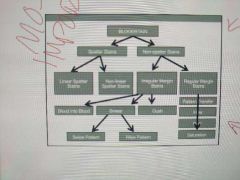![]()
![]()
![]()
Use LEFT and RIGHT arrow keys to navigate between flashcards;
Use UP and DOWN arrow keys to flip the card;
H to show hint;
A reads text to speech;
41 Cards in this Set
- Front
- Back
|
Amended report |
Fixing an error in the original report. |
|
|
Supplemental Report |
Findings in addition to what was previously reported. |
|
|
Scene specific report |
Concentrates on pattern analysis and documentation data. |
|
|
Evidence specific report |
Lab report. Evaluation, results of testing. Normally concentrate on pattern analysis and documentation of stain patterns with only limited reconstruction conclusions. |
|
|
In a final report, how do you refer to another disciplines report or findings? |
"Reportedly..." |
|
|
Every report should include what disclaimer? |
This report is based solely on the information available to me at this time and may be changed or modified with the discovery of new information. |
|
|
What factors do not affect bloodstains? |
Age, sex, disease state, or clinical amounts of alcohol or drugs Does NOT include Race/ethnicity |
|
|
Newton's first law |
A body at rest remains at rest and a body in motion stays in motion. |
|
|
Inertia |
Resistance of a body to change in velocity. Related to mass. More mass=more resistance. |
|
|
Newton's second law |
F=ma |
|
|
What shape is a falling blood drop? |
Sphere |
|
|
Damping time |
A measure of the length of time any fluid will be distorted prior to reassuming the spherical shape. |
|
|
Viscosity of blood vs. water |
Blood is 4x more viscous than water |
|
|
Volume of a blood drop |
50 microliters. |
|
|
I drop something off of 3rd story vs. falling off empire State building, which is falling faster? |
They're the same |
|
|
Maximum terminal velocity |
50 microliters of blood falls at 25.1 ft/sec +/- 0.5 ft/sec |
|
|
MacDonnell about distance fallen |
Any estimate of the distance of a drop fell before impact as a function of the diameter of it's resulting stain is essentially an exercise in futility. |
|
|
Six basic Mechanisms of Bloodstain Patterns |
1. Function of gravity. (Drip, drip trails) 2. By force. (impact, expectorate) 3. Ejected over time from an object in motion (cast off) 4. Ejected in volume under pressure (spurt/gush patterns) 5. Accumulates and/or flows onto a surface (pooling, flow, saturation) 6. Through the transfer (pattern transfers) |
|
|
Four phases of blood drop dynamics |
Contact and collapse. Displacement. Dispersion. Retraction. |
|
|
Frye test |
Case: Frye v. Us Involving: polygraph Changes in court: "general acceptance" |
|
|
Federal rules of Evidence-Rule 702 |
Scientific evidence needs to be helpful relevant and reliable. |
|
|
People v. Owens |
Frye in BPA Improperly admitted bpa evidence for failure to lay a foundation establishing that the technique was based on a well-organized scientific principle. Or that it had gained General acceptance |
|
|
United States v. Mustafa |
Rule 702 in BPA. Rape-murder case where BPA was accepted, not due to general acceptance but because the analysis was based in physics and was reliable, relevant, and helpful. |
|
|
Daubert |
Judge is gatekeeper Five factors: Can itbe/has it been tested? Peer review and publication. Known error rate. Control standards Methodology generally accepted in scientific community. |
|
|
Which standard does the NY court follow? |
Daubert |
|
|
Kumho tire company v. Carmichael |
Daubert factors apply to all areas of expert testimony |
|
|
Weight of evidence |
Jury decides what weight to give experts testimony. |
|
|
Qualifications of experts |
Knowledge Skill Training Experience Education |
|
|
Burden of proof |
On the prosecution |
|
|
Discovery |
Pretrial process in which information is exchanged in prep. |
|
|
Non-linear Spatter |
Impact spatter, drip A series of related spatter stains dispersed over a surface other than in a linear orientation. |
|
|
Impact pattern |
A radiating pattern of small individual drops created when a blood source is broken up at a source by some force. Cone effect dispersion Gunshot, blunt force |
|
|
Expectorate spatter |
Spatter created when blood is forced from the nose, mouth, or respiratory system under pressure. |
|
|
Drips |
Spatter resulting from blood dripping from an individual or otherwise bloodied object. |
|
|
Taxonomy |

|
|
|
Non-spatter family |
3 primary mechanisms: Contact Accumulations of blood Ejections of large volumes |
|
|
What must be written on all sketches? |
Not drawn to scale |
|
|
Blank control sample |
A sample of the same object as control |
|
|
Influences of satellite spatter |
Target surface texture Volume of parent stain Mechanism by which the parent stain is produced Distance traveled prior to striking surface |
|
|
What two things must be present for impact spatter? |
Wet blood and external force. |
|
|
What is the first question for BPA to answer on scene? |
Is this stain blood? |

